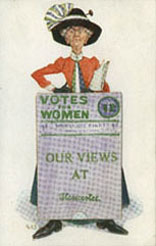Postcards, though now considered a novelty, were considered to be of the upmost social importance during the early 20th century. The 1908 election was decided, in part, on the postcards printed and sent out. The Suffrage Moment also benefited greatly from postcards as women would make and send them out, using them as propaganda to get people on board for their movement.
 Lisa Tickner, a British Suffragist, noted that the pictorial postcard was “possibly the great vehicle for messages of the new urban proletariat between 1900 and 1914’ (it was cheap to buy and to post, simple to use, and quick to arrive in an age of frequent postal deliveries).” Postcards were displayed on coffee tables inside houses, women would join postcard clubs and subscribed to postcard journals, so of course both the suffrage and anti-suffrage movement used postcards to their advantage.
Lisa Tickner, a British Suffragist, noted that the pictorial postcard was “possibly the great vehicle for messages of the new urban proletariat between 1900 and 1914’ (it was cheap to buy and to post, simple to use, and quick to arrive in an age of frequent postal deliveries).” Postcards were displayed on coffee tables inside houses, women would join postcard clubs and subscribed to postcard journals, so of course both the suffrage and anti-suffrage movement used postcards to their advantage.
About 4500 postcards were produced using a suffrage theme. They would use real photos of the suffragists in parades and fighting for their rights. This was used in tandem with written messages about the importance of suffrage as well. These women used something popular at the time to further their cause, as modern feminists use social media today. The anti-suffrage movement also teamed up with the big commercial postcard companies to combat the movement, showing suffragists as humorous and harmless.
To the commercial postcard companies’ dismay, the Suffragists’ efforts prevailed and the 19th amendment was ratified in 1920.
Learn more about Suffrage postcards here: https://www.uni.edu/palczews/NEW%20postcard%20webpage/Postcard%20index.html
